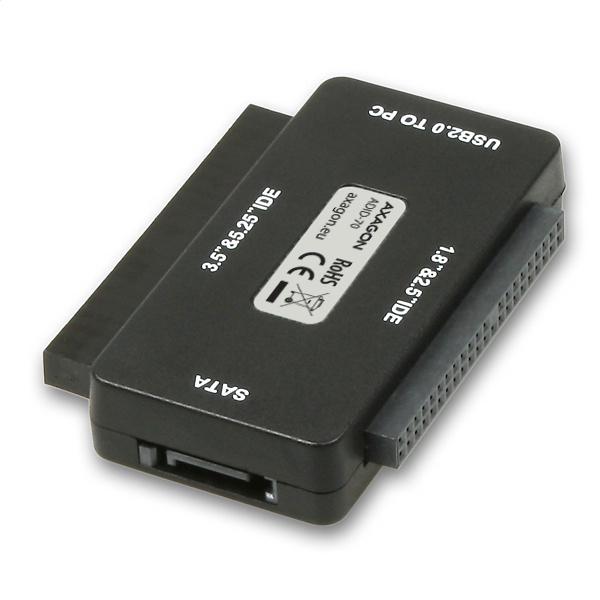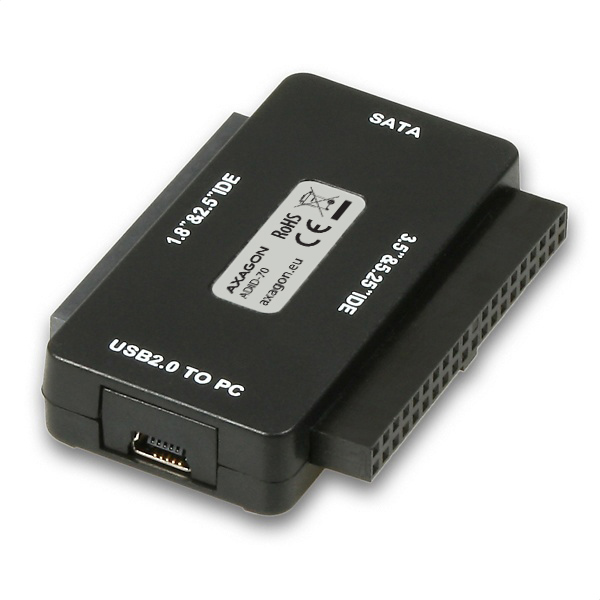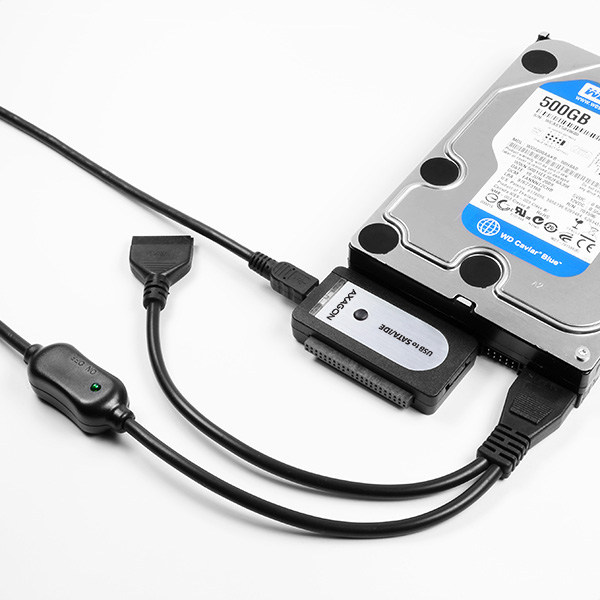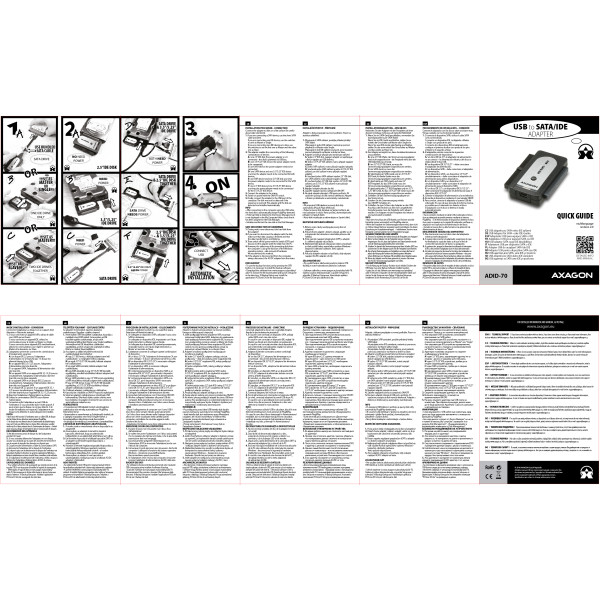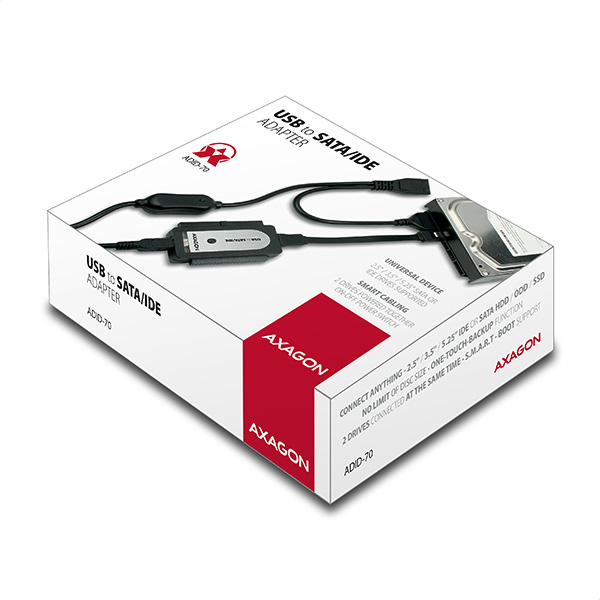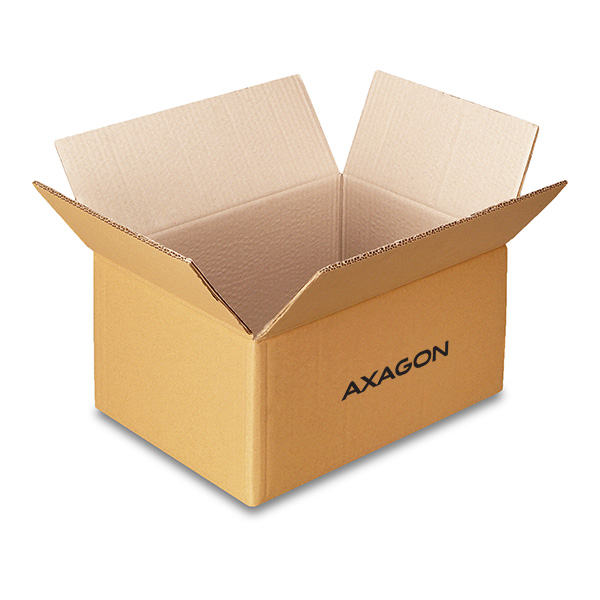ADID-70 USB 2.0 - SATA/IDE
The USB 2.0 adapter for easy connection of all kinds of IDE and SATA disks and drives.
| Input | USB 2.0 |
| Output | SATA, IDE 40-pin, IDE 44-pin, Ultra ATA133 |
| PC connection | USB type A-M, disconnectable cable, cable 80 cm |
| Device support | 2.5" HDD / SSD, 3.5" HDD, 5.25" ODD |
| Power supply | through power adapter |
| Extra | One Touch Backup |
Where to buy
The universal all-in-one AXAGON ADID-70 adapter quickly and easily connects any IDE or SATA device to a PC via USB interface.
Supports all types of 2.5" HDD/SSD, 3.5" hard disks and 5.25" optical CD, DVD or Blu-ray drives.
It deals with all SATA, SATA II and SATA III disks without limiting maximum capacity.
Additionally, the adapter supports the simultaneous connection of either two IDE devices or one IDE and one SATA device.
Cleverly designed cable splitter of the power source with connectors for simultaneous supplying power to SATA and IDE devices.
The power switch allows you to turn off the connected disks while the computer is running without having to disconnect the cables.
One Touch Backup feature to back up your data at one touch of a button on the adapter.
Reading of S.M.A.R.T. information monitoring the condition of the connected disks. Supports spindown of connected disks.
The USB to SATA/IDE converter is a very versatile tool for testing, installing, backing up and copying data.
Input:
• USB 2.0 mini B female connector on the adapter.
• An 80 cm long cable with Type A male connector for connection to a PC.
• USB 2.0 interface, backward compatible with USB 1.1.
• Supports transmission rates 1.5 / 12 / 480 Mbit/s (low / full / high speed).
Outputs:
• 40-pin IDE connector for direct connection of 3.5" disk or 5.25" drive,
• 44-pin IDE connector for direct connection of 2.5" laptop disk,
• 7-pin SATA data male for connection of a SATA disk or drive.
• A 10 cm long SATA data cable with a SATA connector locking latch against interruption of the connection.
• Compliant with Serial ATA 1.0 specification (SATA/150), transmission rates up to 1.5 Gbit/s (150 MB/s).
• Compliant with Ultra ATA/133, supports all PIO and DMA modes, transmission rates up to 133 MB/s.
• The total bandwidth / transmission rate of the adapter is determined by the USB 2.0 interface used (theor. 480 Mbit/s).
Other features:
• Supports 2.5" HDD/SSD, 3.5" HDD and 5.25" optical CD-ROM, DVD-ROM, DVD-RW and Blu-ray drives.
• Supports 2.5" and 3.5" IDE and SATA III/II/I disks without limiting maximum capacity.
• Dual LUN (Logic Unit Number) - simultaneous connection of 2x ATA/ATAPI or 1x ATA/ATAPI + 1x SATA device.
• Supports booting from SSD/HDD connected via an USB adapter.
• HDD Auto Spindown support - possibility to set the interval for disk spindown when idle.
• Possibility to connect your device while running thanks to the Hot Plug support.
• Full Plug and Play support.
• 2x LED indicating connection to USB and data transmission.
• One Touch Backup feature allows you to back up your data from a PC simply by pressing a button on the adapter (in the backup software you can define backup directories at the startup, and then just back up the data to the connected disk at one touch of a button).
• USB adapter dimensions 62 x 42 x 12 mm.
• USB adapter weight 22 g (without cables).
Power supply:
• For 2.5" IDE disk, the USB bus power is sufficient, no power adapter is needed.
• For 2.5" SATA disk, 3.5" disks and 5.25" drives it is necessary to use the power adapter.
• Power adapter parameters: input 100-240V - 50/60Hz, output 5V - 2A / 12V - 2A.
• The power adapter includes a bifurcated "Y" cable with terminals for direct simultaneous power supply to SATA and IDE devices.
• Power switch with power status LED indication.
• Adapter body dimensions 115 x 46 x 33 mm.
• AC adapter weight 200 g (incl. "Y" cable with terminals).
Supported OSs:
• MS Windows XP / Vista / 7 / 8 / 8.1 / 10 and later, Windows Server 2003 / 2008 / 2012 / 2016 and later (supported are all 32- and 64-bit Windows OS versions), Mac OS X 10.x and higher, Linux with kernel 2.6.x and above.
• Note: Drivers are included with supported operating systems and are installed completely automatically. No other drivers need to be installed and are not even available. Backup software to download from the support pages at www.axagon.eu.
Package contains:
• USB 2.0 - IDE/SATA adapter,
• 80 cm USB cable,
• SATA data cable 10 cm,
• power adapter 100-240V / 12V-2A with 70 cm cable,
• three-pin power cord 150 cm,
• a multilingual manual ENG/CZ/DE/ESP/FR/HU/IT/PL/RO/RU/SK/BG,
• packed in a cardboard box.
| Input | |
| interface | USB 2.0 / USB 1.1 |
| rate | 480 / 12 Mbit/s (high / full speed) |
| connector | USB 2.0 Mini B female (on the USB adapter) |
| connector | USB Type A male (on the cable) |
| cable | 80 cm, disconnectable |
| Output | |
| interface | ATA/133, ATA/100, ATA/66, ATA/33 |
| interface | Serial ATA 1.0 |
| rate | 133 MB/s (ATA) or 1.5 Gbit/s (SATA) |
| connector | 40-pin IDE female (for 3.5" disk or 5.25" drive) |
| connector | 44-pin IDE female (for 2.5" disk) |
| connector | 7-pin SATA data male (for SATA disk or drive) |
| cable | SATA data, 10 cm, disconnectable |
| compatibility | all IDE / ATA / ATAPI a SATA I / SATA II / SATA III disks and drives |
| total permeability | 480 Mbit/s theoretically (given by USB 2.0 input) |
| Supported device | |
| 2.5" | yes (IDE and SATA HDD/SSD) |
| 3.5" | yes (IDE and SATA HDD) |
| 5.25" | yes (ATAPI and SATA CD/DVD/DVD-RW/Blu-ray) |
| max. disk capacity | all, without limitations |
| max. height of 2.5" disk | all, without limitations |
| Supported features | |
| S.M.A.R.T. | yes |
| boot from connected disk | yes |
| putting disk to sleep | yes (HDD Auto Spindown support) |
| disk turning off | no (HDD Turn Off) |
| automatic installation | yes |
| Plug and Play | yes |
| Hot Plug | yes |
| Other features | |
| design | plastic |
| screwless mounting | yes |
| indication | blue LED - data transmission (flashes) |
| indication | red LED - connection to the power supply (permanently on) |
| controls | One Touch Backup button - backups the data from the PC by pressing the button |
| controls | power switch with power status LED indication |
| dimensions | 62 x 42 x 12 mm |
| weight | 22 g (without cables) |
| Power supply | |
| on the bus | yes (USB bus power only for 2.5" IDE HDD) |
| through power adapter | yes (power adapter included) |
| OS support | |
| MS Windows | 10 / 8.1 / 8 / 7 / Vista / XP (all 32- and 64-bit versions) |
| MS Windows Server | 2016 / 2012 / 2008 / 2003 (all 32- and 64-bit versions) |
| Mac OS | X 10.x and higher |
| Linux | kernel 2.6.x and higher |
Package contents
- USB 2.0 - IDE/SATA adapter
- USB cable 80 cm
- SATA data cable 10 cm
- power adapter with Y cable 70 cm
- power cord 150 cm
- user manual
Product package
- cardboard box
- package dimensions 13.3 x 4.2 x 19.1 cm
- weight of 1 pc package 393 g
- EAN 8595247900708
Export package
- number of pieces in the box: 40
- total weight of the box: 16.25 kg G.W.
- box dimensions: 29.5 x 39.5 x 46.5 cm
FAQ
A): If the external box (adapter / docking station) is not displayed in "Device Manager", there may be a USB port malfunction. It is also possible that your computer has a poor power supply to USB ports and the power is not sufficient to operate an external box (you can detect by listening that HDD is not spinning). This is a problem especially for older computers, where the source part already works at the limit of its parameters. In this case, it would help to use a USB hub, with an auxiliary power supply, by which the external box (adapter / docking station) would be connected to the computer.
B): Try plugging the external box (adapter / docking station) into another USB port, preferably on the back of your PC. The external box (adapter / docking station) should be detected and the drivers loaded automatically. If the problem persists, plug the external box (adapter / docking station) into the USB port of another computer to verify its functionality.
A): If this happens, it means that the operating system failed to get the necessary information to install the drivers.
B): The cause may be a defective USB cable or damaged device. If the problem persists, plug the external box (adapter / docking station) into the USB port of another computer to verify its functionality.
A): If this happens, it means that the Windows operating system did not assign a drive letter to the new storage device.
B): If the drive letter is not assigned, open "Disk Management", right-click on the desired drive and manually assign the drive letter. If the drive letter can not be assigned to the disk, it is possible that the disk is formatted as "dynamic". If you want to keep disk data, connect it to the original device and make a backup of the disk. Then convert it to a normal disk, initialize it to MBR (or GPT, see other points), and then perform Low Level Format (e.g. using the Low Level Format Tool)
A): The newly purchased disk must be initialized before first use.
B): If the new disk is not initialized automatically, open "Disk Management", right-click on the desired disk and initialize it.
A): By initializing the disk, you can set the mode in which the hard disk will work.
B): You can use the partition with the master boot record (MBR) or the GUID partition table (GPT). For disk up to 2TB, use the MBR option, we recommend selecting GPT on a larger disk than 2TB. Subsequently, the initialized disk should be formatted.
A): If the external box (adapter / docking station) with a 3.5“ HDD is not displayed in "Device Manager ", the inserted disk may not be powered.
B): Make sure you have the power supply plugged in and the external box (adapter / docking station) turned on with the power switch. If the disk is properly powered, it should spin (can be detected by listening).
A): The AXAGON external boxes (adapters / docking stations) are always equipped with the latest firmware to support disks of all capacities.
B): The 2TB limit is given as the maximum partition size when initializing a disk with the master boot record (MBR). If you want to create a larger partition on the HDD stored in the external box (e.g. 3TB or more), you must select the GUID partition table (GPT) when initializing the disk. Subsequently, the initialized disk should be formatted.
A): The external AXAGON boxes (adapters / docking stations) support the USB Mass Storage protocol making it easy to connect to TV.
B): When using a disk larger than 2TB, some TVs do not support GPT format. In such case, MBR format must be used when initializing a disk.
A): The connectors are compatible, but inside the USB 3.0 connector has five more contacts. The USB 3.2 Gen 1 (USB 3.0) connector is usually identified by the use of blue (exceptionally black) plastic.
B): The main difference is the speed of data transmission. USB 2.0 reaches a maximum speed of about 30 MB/s, while USB 3.2 Gen 1 (USB 3.0) is able to achieve a theoretical speed of up to 600 MB/s. If you place a disk in the external box that has a read speed of 120 MB/s, you can only get a quarter speed, that is about 30 MB/s, in the box with USB 2.0.
A): For proper spin-down setting, this feature must be supported by all components that are in the path between the operating system and the HDD, i.e. the USB controller, box electronics, and the disk itself. The spinning down of idle disks is set up by the operating system, but it is very complicated.
B): We recommend setting up using one of the freeware programs, where the procedure is mostly simplified. E.g. by HDDScan (http://hddscan.com/). The program has the ability to verify whether the disk and all components in the path support the feature. Select "Spindown" to test an immediate spin down of the disk. Set up the spindown time using a slider in the "Power Management" section.

